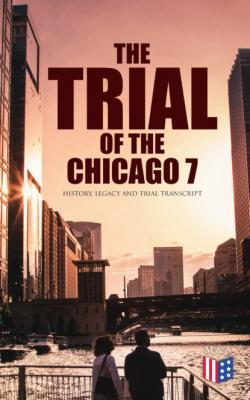ТОП просматриваемых книг сайта:
The Trial of the Chicago 7: History, Legacy and Trial Transcript. Bruce A. Ragsdale
Читать онлайн.Название The Trial of the Chicago 7: History, Legacy and Trial Transcript
Год выпуска 0
isbn 4064066383282
Автор произведения Bruce A. Ragsdale
Жанр Документальная литература
Издательство Bookwire
8. Did the attitude and demeanor of Judge Hoffman and the government attorneys violate the defendants’ right to a fair trial?
Yes. The U.S. Court of Appeals of the Seventh Circuit found that the demeanor of the judge and the government attorneys was sufficient reason to reverse the convictions.
The court of appeals found that from the opening of the trial, the district judge made clear his “deprecatory and often antagonistic attitude toward the defense.” Judge Hoffman had consistently made sarcastic and gratuitous criticisms of the defense attorneys. The appeals court was especially disturbed that Judge Hoffman had denigrated the defense’s key argument that the Daley administration and the Chicago police deliberately provoked the demonstrators. Judge Hoffman’s most serious offense, according to the court of appeals, was to make these caustic remarks in front of the jury.
On procedural questions, Judge Hoffman consistently ruled against the defense, and he failed to restrain the U.S. attorney’s personal attacks on the defendants. The court of appeals considered U.S. Attorney Thomas Foran’s closing arguments, with their emphasis on dress and appearance and references to “evil men” and “violent anarchists,” beyond all standards of acceptable behavior. The court of appeals acknowledged the disruptive behavior of the defendants, but that behavior did not justify a disregard of “the high standards for the conduct of judges and prosecutors.” “A defendant ought not to be rewarded for success in baiting the judge and the prosecutor.”
Legal Arguments in Court
The attorneys for the U.S. government
U.S. Attorney Thomas Foran and Assistant U.S. Attorney Richard Schultz argued
that:
1 The seven (originally eight) defendants conspired to provoke government violence against the demonstrators at the Democratic National Convention in Chicago. The prosecutors acknowledged that the defendants had never met as a group, but seven had met in smaller groups to devise their strategy and to coordinate demonstrators’ resistance to the police. The testimony of government witnesses established a “tacit understanding” among the defendants and a mutual understanding of the goals of the conspiracy.
2 The defendants intended to incite violence by attracting to Chicago very large crowds to participate in ostensibly peaceful protests of the Vietnam War and social injustice. The defendants incited the demonstrators against the police, the National Guard, and the Army, and the defendants orchestrated confrontations with the intent of provoking law enforcement officers to respond with violence.
3 The defendants privately and in small gatherings, before and during the week of the convention, described their goals of disruption and confrontation, and their goal of inciting not only riots in Chicago, but a popular uprising against the government. The government attorneys cited the defendants’ rhetoric about hoping to “smash the city,” bringing “the United States military machinery to a halt,” and creating the “first steps towards the revolution” as proof that the seven organizers jointly planned to incite violence in Chicago during the Democratic Convention.
4 At least six of the original defendants crossed state lines with the intent to incite violence and thus violated the anti-riot provisions of the Civil Rights Act of 1968.
5 Froines and Weiner discussed the manufacture and possible uses of incendiary devices during the convention.
The attorneys for the defendants
William Kunstler and Leonard Weinglass, attorneys for the seven defendants, rejected a strategy that focused closely on disproving the charges in the indictment. Rather, they emphasized that this was, in their view, more of a political trial than a criminal prosecution. The defense called many witnesses to rebut the testimony of the undercover police, but their goal was always to establish the peaceable intent of the defendants and to expose the political motivation of the prosecution. In their opening and closing arguments, the defense attorneys argued that:
1 The U.S. and Chicago governments engaged in a conspiracy to prevent demonstrations against the Vietnam War and related issues. Kunstler argued that “the police of this city embarked on an organized conspiracy of berserk brutal action against these demonstrators.”
2 The prosecution witnesses, who were almost all government employees or informants paid by the government, could not offer impartial or credible testimony. The defense asked the jury to consider why the government had called no by-standers as witnesses of the violence during the convention.
3 The indictment, and particularly the conspiracy charge, was on the face of it absurd. The charges in the indictment implied that seven veterans of the peace movement suddenly rejected their long-standing beliefs and embraced a violent strategy sure to result in their imprisonment.
4 A large number of witnesses, including prominent politicians and entertainers who performed at the protest rallies, testified that they had heard no incitements to violence during the planning and staging of rallies surrounding the convention; nor had they witnessed any diversionary tactics designed to provoke police violence.
5 The indictment represented an assault on First Amendment rights. With their frequent reference to the American Revolution and the Founders, the defense attorneys placed the defendants’ activities in Chicago in an American tradition of popular defense of liberties.
Biographies
Table of Contents
Julius Jennings Hoffman (1895-1983)
William Joseph Campbell (1905-1988)
Judges of the U.S. Court of Appeals for the Seventh Circuit
Walter Joseph Cummings (1916-1999)
Thomas Edward Fairchild (1912-2007)

